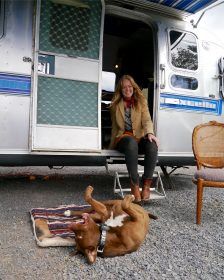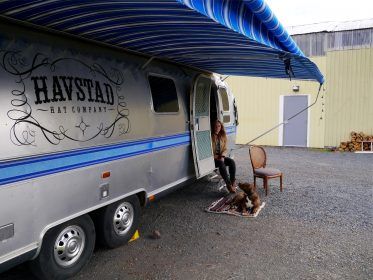An unfortunate incident a few years ago launched Cate Havstad into the business of hat building. Her sweet lab-mix dog Charlie, at the time a naughty puppy, chewed up her prized possession: an old flat top hat of very sentimental value. “It was a very special hat,” she said. “I started researching how I could fix it, which led me to looking into custom hatters. That opened up a Pandora’s box! I found out that people have been doing this pretty much the same way with the same tools since the 1800’s.”
“It was fascinating,” she said. “There’s a tiny little pocket of master hatters left.” She chose one to apprentice with—later found other mentors in the field—and began building hats out of a horse barn before she moved her business into her 32-foot 1986 Excella.
She wasn’t married to the idea of an Airstream at first; she was merely thinking mobile. “I wanted to have a job doing what I love and still have the freedom to travel and see my friends around the country,” she said. “I think I find a lot of inspiration through my travels.” But Havstad wasn’t sure if the circuitry in a trailer could handle her electrical equipment, and was concerned about the protection and storage of her essential collection of vintage hat blocks dating from the 1920s.
After measuring the Excella (formerly used as an art studio by a friend) and mapping the studio plan and workstations, she was ready to make the move but needed help with the buildout. Havstad enlisted another friend, someone she’s been close to since the second grade from Occidental, her tiny hometown in Sonoma County, California. “I said, ‘I have no money to do this, help!’” Now in the construction business, he was able to do the aluminum fabrication and installed the flooring, made of early 1900s redwood they found at a salvage yard. “I love being surrounded by wood,” said Havstad. “My favorite homes have been log cabins. All of my tools are old wood tools.
The Airstream is plumbed with functioning electricity and supports all her unique hatmaking machinery: a steam boiler (for shaping), a gravity feed iron, a spinning station, and a crown iron from the 1920s. “Most of my machinery is pretty old,” said Havstad, who searches for it online and through contacts. “It's like treasure hunting.”

There’s also a sewing station with storage for all her ribbons, hatbands, and threads; a cupboard housing experimental hats; and her bench of hand tools, “probably one of my favorite little areas in the whole place,” she said. “I have to keep in mind that I've got all this really important stuff, so how do I travel with it safely?” Among her tools are a tolliker (that breaks the crown from the brim at a sharp 90° angle), a pusher-downer, (“that’s a technical term”), a puller-downer, and a brim cutter.
The task of turning the gutted Excella into a hat workshop was completed quickly, under a deadline and with a tiny budget, just in time to tow it on a pre-planned sponsored tour. “I set up the tour before I had the Airstream built!” she laughed. “So there's some projects that we just didn't get to in time. This thing will kind of be a constant work in progress. It could use a new paint job, and I’d love to buff it.”
Her “Hatter and the Hound” tour covered 8000 miles across the West to Tennessee and back. “I was inspired by Travels with Charlie—that’s one of my favorite books.” (Her Charlie, the mischievous mutt who started it all, is named for Steinbeck’s sidekick.) “I just kind of knew that one day I’d travel around the country with my dog.”
Havstad uses social media to connect with customers, and often lets serendipity determine her destinations. “When I was planning the last last year's tour I just threw it out there to the world and said ‘I'm doing this. If you're in a certain city and you think I should go somewhere please let me know’. I let feedback direct me a bit, and just hosted pop-ups.” In Austin she was set up at the hip White Horse Saloon; in Colorado, she simply parked on a ranch in tiny mountain town. “That was actually one of my best stops,” she said. “Everyone in that small town all kind of told each other, and people came in and placed orders! I let it all happen as organically as I can.”
“Airstream people are so cool,” she added. “Anyone who saw me pulling this who was an Airstream person would come and ask me about it, and ask what year it is. I would say, it's my workshop! They would peek in here I would watch a little switch flip in their mind, like, ‘hmm, what could I do? Wow, maybe I could build custom motorcycles out of an Airstream?’ That was the coolest part of the whole trip.”
“I found something I really, really love to do, and what a dream to find work you really love,” she said. “And being mobile is affordable, and it allows you a lot of freedom.”

When her Airstream comes to rest, Havstad gets to work creating one-of-a-kind hats for her customers, and has her own line of styles using natural dyes—redosier dogwood, high desert sage, fermented lichen with usnea—that are named for the regional influences that inspire them: the Oregon Outlaw, the Whiskey Comatose, the Texas Waltz, the Muir. “There are some funky experimental things I like to do with the classic Western shapes, giving them kind of a new twist,” she explained. (Her traditional Open Road hat is baby blue.)
Havstad Hats are made from rabbit fur, beaver blends, and 100% beaver. “Beaver is the best because it's a naturally water repellent fiber, and it's also very durable,” she explained. “It's the sort of thing that should last a lifetime. Or longer.” Customers often order a Havstad Hat that becomes an instant heirloom with sentimental value. “They contact me with a story about a grandfather, and send a photo of him wearing a hat they want re-created, with an article of clothing he wore to be integrated into the hatband,” she said. Other parts of the hat can carry special meaning, too, “I stamp all of the sweatbands with something, either ‘handcrafted for’ with the person’s name, or a saying, and the name of plant used to dye it.”
Havstad’s personal hat is stamped with one of her favorite quotes: “Breathe it all in, love it all out.”
By RG Coleman









